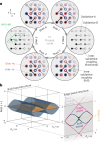Parity-time-symmetric photonic topological insulator
- PMID: 38195865
- PMCID: PMC11349580
- DOI: 10.1038/s41563-023-01773-0
Parity-time-symmetric photonic topological insulator
Abstract
Topological insulators are a concept that originally stems from condensed matter physics. As a corollary to their hallmark protected edge transport, the conventional understanding of such systems holds that they are intrinsically closed, that is, that they are assumed to be entirely isolated from the surrounding world. Here, by demonstrating a parity-time-symmetric topological insulator, we show that topological transport exists beyond these constraints. Implemented on a photonic platform, our non-Hermitian topological system harnesses the complex interplay between a discrete coupling protocol and judiciously placed losses and, as such, inherently constitutes an open system. Nevertheless, even though energy conservation is violated, our system exhibits an entirely real eigenvalue spectrum as well as chiral edge transport. Along these lines, this work enables the study of the dynamical properties of topological matter in open systems without the instability arising from complex spectra. Thus, it may inspire the development of compact active devices that harness topological features on-demand.
© 2024. The Author(s).
Conflict of interest statement
The authors declare no competing interests.
Figures




References
-
- Klitzing, K. V., Dorda, G. & Pepper, M. New method for high-accuracy determination of the fine-structure constant based on quantized Hall resistance. Phys. Rev. Lett.45, 494–497 (1980).10.1103/PhysRevLett.45.494 - DOI
Grants and funding
LinkOut - more resources
Full Text Sources
Research Materials

